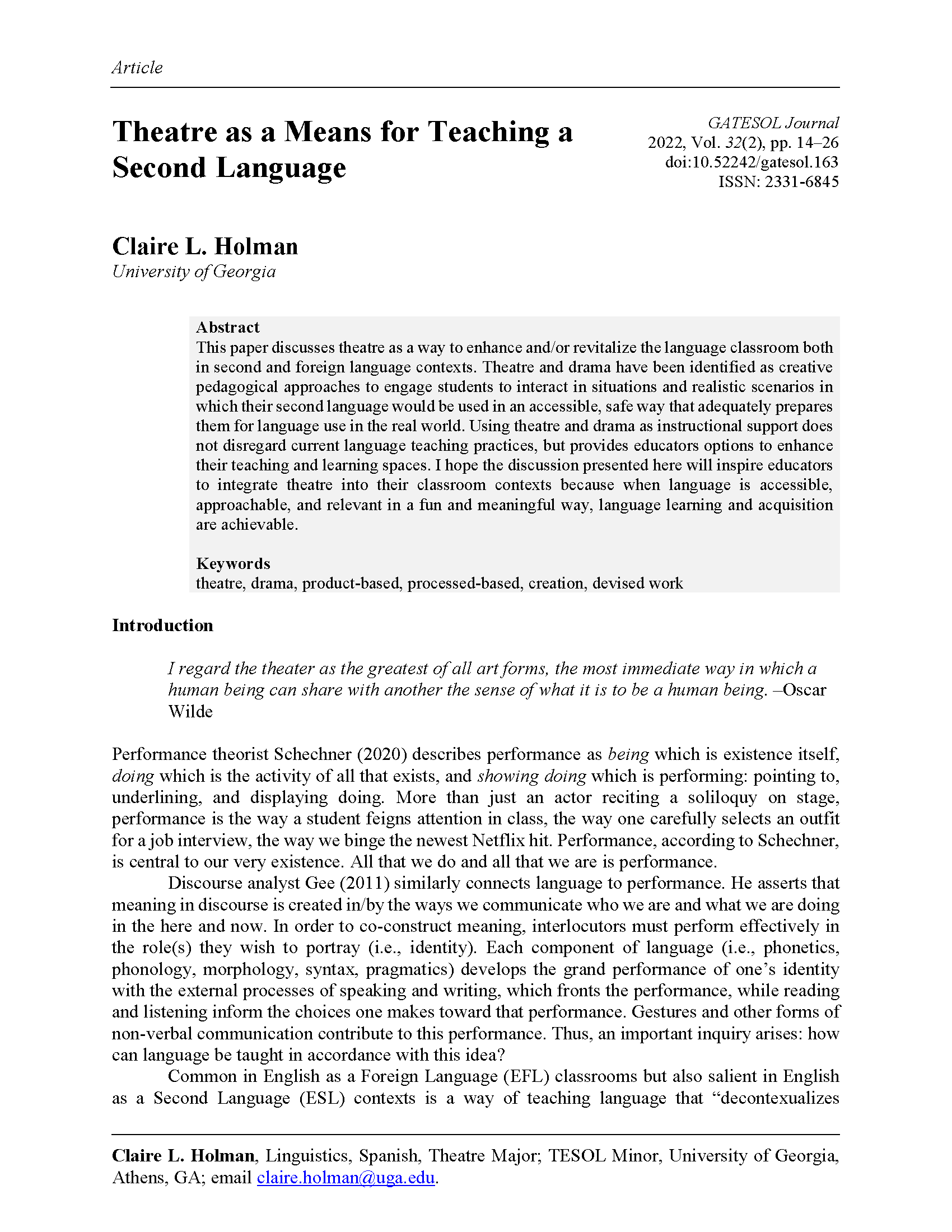Theatre as a Means for Teaching a Second Language
DOI:
https://doi.org/10.52242/gatesol.163Keywords:
theatre, drama, product-based, processed-based, creation, devised workAbstract
This paper discusses theatre as a way to enhance and/or revitalize the language classroom both in second and foreign language contexts. Theatre and drama have been identified as creative pedagogical approaches to engage students to interact in situations and realistic scenarios in which their second language would be used in an accessible, safe way that adequately prepares them for language use in the real world. Using theatre and drama as instructional support does not disregard current language teaching practices, but provides educators options to enhance their teaching and learning spaces. I hope the discussion presented here will inspire educators to integrate theatre into their classroom contexts because when language is accessible, approachable, and relevant in a fun and meaningful way, language learning and acquisition are achievable.
References
Anderson, J. (2021). A framework for project-based learning in TESOL. Modern English Teacher, 30(2), 45–49.
Burke, A. F., & O’Sullivan, J. (2002). Stage by stage: A handbook for using drama in the second language classroom. Heinemann Drama.
Carson, L. (2012). The role of drama in task-based learning: Agency, identity and autonomy. Scenario: A Journal of Performative Teaching, Learning, Research, 6(2), 47–60. https://doi.org/10.33178/scenario.6.2.6
Davies, P. (1990). The use of drama in English language teaching. TESL Canada Journal, 8(1), 87–99. https://doi.org/10.18806/tesl.v8i1.581
DiNapoli, R. (2009). Using dramatic role-play to develop emotional aptitude. International Journal of English Studies, 9(2), 97–110.
Dodson, S. (2002). The educational potential of drama in ESL. In G. Bräuer (Ed.), Body and language (pp. 161–179). Praeger.
Ellis, R. (2015). Understanding second language acquisition (2nd ed.). Oxford University Press.
Fonio, F. (2012). Stuffed pants! Staging full-scale comic plays with students of Italian as a foreign language. Scenario: A Journal of Performative Teaching, Learning, Research, 6(2), 18–27. https://doi.org/10.33178/scenario.6.2.4
Gee, J. (2011). Social linguistics and literacies: Ideology in discourses. Hoboken.
Hann, D. (2017). Building rapport and a sense of communal identity through play in a second language classroom. In N. Bell (Ed.), Multiple Perspectives on Language Play (pp. 219–244). Walter de Gruyter.
Kuyumcu, F. N. (2013). Using theatre techniques in foreign language education: A study on Molière’s plays. Procedia: Social and Behavioral Sciences, 70, 6–10. https://doi.org/10.1016/j.sbspro.2013.01.032
Lee, B. K., Enciso, P., & Brown, M. R. (2020). The effect of drama-based pedagogies on K–12 literacy-related outcomes: A meta-analysis of 30 years of research. International Journal of Education and the Arts, 21(30), 1–30. http://doi.org/10.26209/ijea21n30
Lei, L. W., & Huang, C. F. (2012). Learning English through musicals: A case study of social economically disadvantaged aboriginal students in Eastern Taiwan. International Journal of Humanities and Arts Computing: A Journal of Digital Humanities, 6(1–2), 204–210. https://doi.org/10.3366/ijhac.2012.0049
Maley, A., & Duff, A. (1978). Drama techniques in language learning. Cambridge University Press.
Meisner, S., Longwell, D., & Pollack, S. (1987). Sanford Meisner on acting (1st ed.). Vintage.
Mermikides, A., & Smart, J. (2010). Devising in process. Red Globe Press.
Moody, D. J. (2002). Undergoing a process and achieving a product: A contradiction in educational drama? In G. Bräuer (Ed.), Body and language (pp. 135–160). Praeger.
Ntelioglou, B. Y. (2011). “But why do I have to take this class?” The mandatory drama-ESL class and multiliteracies pedagogy. Research in Drama Education: The Journal of Applied Theatre and Performance, 16(4), 595–615. https://doi.org/10.1080/13569783.2011.617108
Pandian, A., Ling, C. L. C., Lin, D. T. A., Muniandy, J., Choo, L. B., & Hiang, T. C. (Eds.). (2014). Language teaching and learning: New dimensions and interventions. Cambridge.
Pang, M. (2019). Developing core practices for EFL/ESL teaching: A framework for methodology course design. TESOL Quarterly, 53(1), 258–273. https://doi.org/10.1002/tesq.487
Park, H. (2015). Student perceptions of the benefits of drama projects in university EFL: Three case studies in Korea. English Teaching: Practice & Critique, 14(3), 314–334. https://doi.org/10.1108/ETPC-06-2015-0047
Royka, J. G. (2002). Overcoming the fear of using drama in English language teaching. Internet TESL Journal, 8(6). http://iteslj.org/Articles/Royka-Drama.html
Scally, G. (2019). Group devised theatre for second language acquisition [Doctoral dissertation, University of Manchester]. ProQuest.
Schechner, R. (2020). Performance studies: An introduction (4th ed.). Routledge.
Smith, S. M. (1984). The theater arts and the teaching of second languages. Addison-Wesley.
Stern, S. (1980). Drama in second language learning from a psycholinguistic perspective. Language Learning, 30(1), 77–100. https://doi.org/10.1111/j.1467-1770.1980.tb00152.x
Wagner, B. J. (1979). Using drama to create an environment for language development. Language Arts, 56(3), 268–274.
Wagner, B. J. (2002). Understanding drama-based instruction. In G. Bräuer (Ed.), Body and language (pp. 1–18). Ablex.
Wessels, C. (1987). Drama. Oxford University Press.

